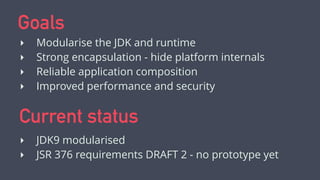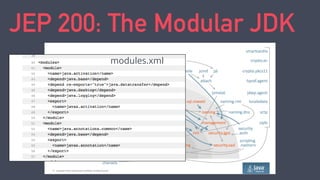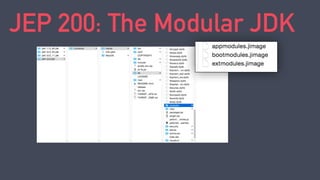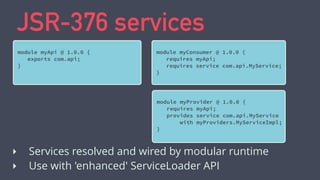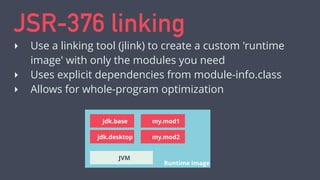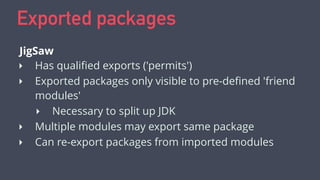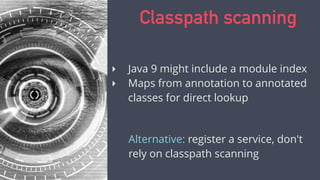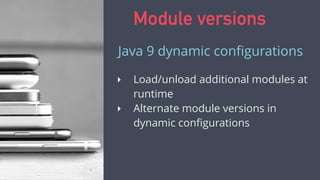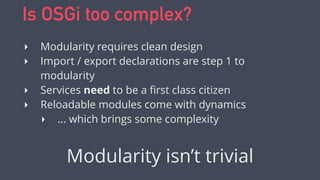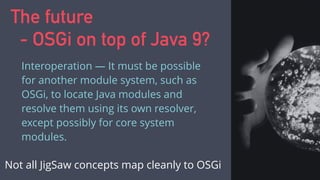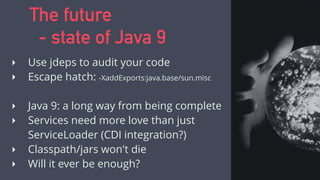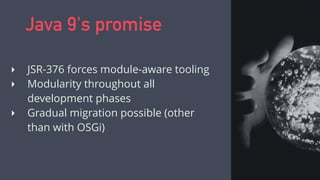Java modularity: life after Java 9
- 1. Java Modularity: life after Java 9 @pbakker sdd @Sander_Mak Luminis Technologies
- 2. Today's journey Modularity matters Java 9 modularity JigSaw & OSGi The Future
- 3. Modularity matters Modularity is the ultimate agile tool
- 4. Good fences make good neighbours Hide your internals! Service contract Module
- 5. Contracts & Services MyInterface i = new MyImpl(); How to use code that you can’t access?
- 6. Contracts & Services Provider module Service Registry Consumer module Register service Lookup service Inject service Use an interface as contract
- 8. We don't have inside info Java 9: JigSaw, JSR-376
- 9. History of JigSaw JSR-277 Java Module System 2005 2006 2011 2014 JSR-294 Improved Modularity Support Java 7: No JigSaw Java 8: No JigSaw JSR-376 Java Platform Module System JSR-291 'OSGi 4.1'
- 10. Goals ‣ Modularise the JDK and runtime ‣ Strong encapsulation - hide platform internals ‣ Reliable application composition ‣ Improved performance and security Current status ‣ JDK9 modularised ‣ JSR 376 requirements DRAFT 2 - no prototype yet
- 11. Goals ‣ Modularise the JDK and runtime ‣ Strong encapsulation - hide platform internals ‣ Reliable application composition ‣ Improved performance and security Current status ‣ JDK9 modularised ‣ JSR 376 requirements DRAFT 2 - no prototype yet Final Yesterday
- 12. They modularised the JDK without the module system? So you're telling me...
- 13. JEP 200: The Modular JDK
- 14. modules.xml JEP 200: The Modular JDK
- 15. JEP 200: The Modular JDK
- 16. JEP 200: The Modular JDK rt.jar & tools.jar gone Faster startup, lower footprint
- 17. JSR-376 modules module myFirstModule @ 1.0.0 { exports com.public.api; requires myOtherModule @ 1.0; } module-info.java ‣ Dependencies are transitively resolved on modulepath ‣ Versions: ordered, but not semantic ‣ Access control happens deep in VM (IllegalAccessException)
- 18. JSR-376 modules module myFirstModule @ 1.0.0 { exports com.public.api; requires myOtherModule @ 1.0; } module-info.java ‣ Dependencies are transitively resolved on modulepath ‣ Versions: ordered, but not semantic ‣ Access control happens deep in VM (IllegalAccessException) in Jar, or new jmod container
- 19. JSR-376 services module myApi @ 1.0.0 { exports com.api; }
- 20. JSR-376 services module myApi @ 1.0.0 { exports com.api; } module myConsumer @ 1.0.0 { requires myApi; requires service com.api.MyService; }
- 21. JSR-376 services module myApi @ 1.0.0 { exports com.api; } ‣ Services resolved and wired by modular runtime ‣ Use with 'enhanced' ServiceLoader API module myConsumer @ 1.0.0 { requires myApi; requires service com.api.MyService; } module myProvider @ 1.0.0 { requires myApi; provides service com.api.MyService with myProviders.MyServiceImpl; }
- 22. JSR-376 services module myApi @ 1.0.0 { exports com.api; } ‣ Services resolved and wired by modular runtime ‣ Use with 'enhanced' ServiceLoader API module myConsumer @ 1.0.0 { requires myApi; requires service com.api.MyService; } module myProvider @ 1.0.0 { requires myApi; provides service com.api.MyService with myProviders.MyServiceImpl; } Iterable<App> apps = ServiceLoader.load(App.class); for(App app: apps) { render(app); }
- 24. JSR-376 linking ‣ Use a linking tool (jlink) to create a custom 'runtime image' with only the modules you need ‣ Uses explicit dependencies from module-info.class ‣ Allows for whole-program optimization Runtime image jdk.base jdk.desktop my.mod1 my.mod2 JVM
- 26. Module vs package dependencies ‣ Module dependency: depend on a module, no matter what’s in it ‣ Package dependencies still exist in code (imports) ‣ What if a package moves to a different bundle? ‣ Package dependency: depend on a package, no matter where it comes from ‣ Better decoupling
- 27. Module vs package dependencies class package module imports exports exports imports class package bundle exports exports Java 9 OSGi imports imports
- 28. Exported packages ‣ Has qualified exports ('permits') ‣ Exported packages only visible to pre-defined 'friend modules' ‣ Necessary to split up JDK ‣ Multiple modules may export same package ‣ Can re-export packages from imported modules JigSaw
- 29. Services ‣ Services are explicit in module metadata ‣ Service wiring statically verifiable? JigSaw OSGi ‣ Services wired programmatically ‣ Service dynamics & bundle lifecycle ‣ Services can have properties, filters
- 30. ‣ Java 9 might include a module index ‣ Maps from annotation to annotated classes for direct lookup Classpath scanning Alternative: register a service, don't rely on classpath scanning
- 31. ‣ Requiring multiple module versions is common ‣ Breaks in a flat class path Module versions MyModule LoggingLib 2.0 LoggingLib 1.0 SomeLib
- 32. ‣ OSGi supports this with version ranges Import-Package: org.slf4j;version=“[1,2)” Module versions
- 33. ‣ JSR-376 draft spec states: “It is not necessary to support more than one version of a module within a single configuration.” Module versions
- 34. ‣ Load/unload additional modules at runtime ‣ Alternate module versions in dynamic configurations Java 9 dynamic configurations Module versions
- 35. ‣ Add, remove, update bundles at runtime ‣ Services are inherently dynamic OSGi Java 9 ‣ Dynamic configurations need to be supported for Java EE ‣ Unclear how
- 36. How would the OSGi demo be structured in Java 9/JigSaw?
- 37. jdeps carprov.music.jar carprov.music (carprov.music.jar) -> carprov.dashboard.api carprov.dashboard.api.jar -> java.lang java.base -> java.lang.invoke java.base -> javafx.collections jfxrt.jar -> javafx.event jfxrt.jar -> javafx.geometry jfxrt.jar -> javafx.scene jfxrt.jar -> javafx.scene.effect jfxrt.jar -> javafx.scene.image jfxrt.jar -> javafx.scene.input jfxrt.jar -> javafx.scene.layout jfxrt.jar -> javafx.scene.paint jfxrt.jar -> org.osgi.framework org.osgi.core.jar
- 38. module-info.java module carprov.dashboard @ 1.0.0 { exports carprov.dashboard.api requires org.osgi.core @ 5.0 requires service carprov.dashboard.api.App } module carprov.music @ 1.0.0 { requires carprov.dashboard @ 1.0 requires org.osgi.core @ 5.0 provides service carprov.dashboard.api.App with carprov.music.MusicApp }
- 39. ... is OSGi too complex? So that looks simple enough ...
- 40. ‣ Modularity requires clean design ‣ Import / export declarations are step 1 to modularity ‣ Services need to be a first class citizen ‣ Reloadable modules come with dynamics ‣ ... which brings some complexity Modularity isn’t trivial Is OSGi too complex?
- 41. The future
- 42. The future - OSGi on top of Java 9? Interoperation — It must be possible for another module system, such as OSGi, to locate Java modules and resolve them using its own resolver, except possibly for core system modules. Not all JigSaw concepts map cleanly to OSGi
- 43. ‣ A future OSGi could use the module definitions of Java 9 ‣ Project Penrose: OSGi/JigSaw interop (looks inactive currently) ‣ Jars with module-info.class & OSGi metadata possible The future - OSGi on top of Java 9?
- 44. ‣ Use jdeps to audit your code ‣ Escape hatch: -XaddExports:java.base/sun.misc ‣ Java 9: a long way from being complete ‣ Services need more love than just ServiceLoader (CDI integration?) ‣ Classpath/jars won't die ‣ Will it ever be enough? The future - state of Java 9
- 45. ‣ JSR-376 forces module-aware tooling ‣ Modularity throughout all development phases ‣ Gradual migration possible (other than with OSGi) Java 9's promise
- 46. ‣ JSR-376 forces module-aware tooling ‣ Modularity throughout all development phases ‣ Gradual migration possible (other than with OSGi) Java 9's promise Spotlight on modularity == good
- 47. @pbakker sdd @Sander_Mak Luminis Technologies Thank you. code @ bit.ly/carprov









